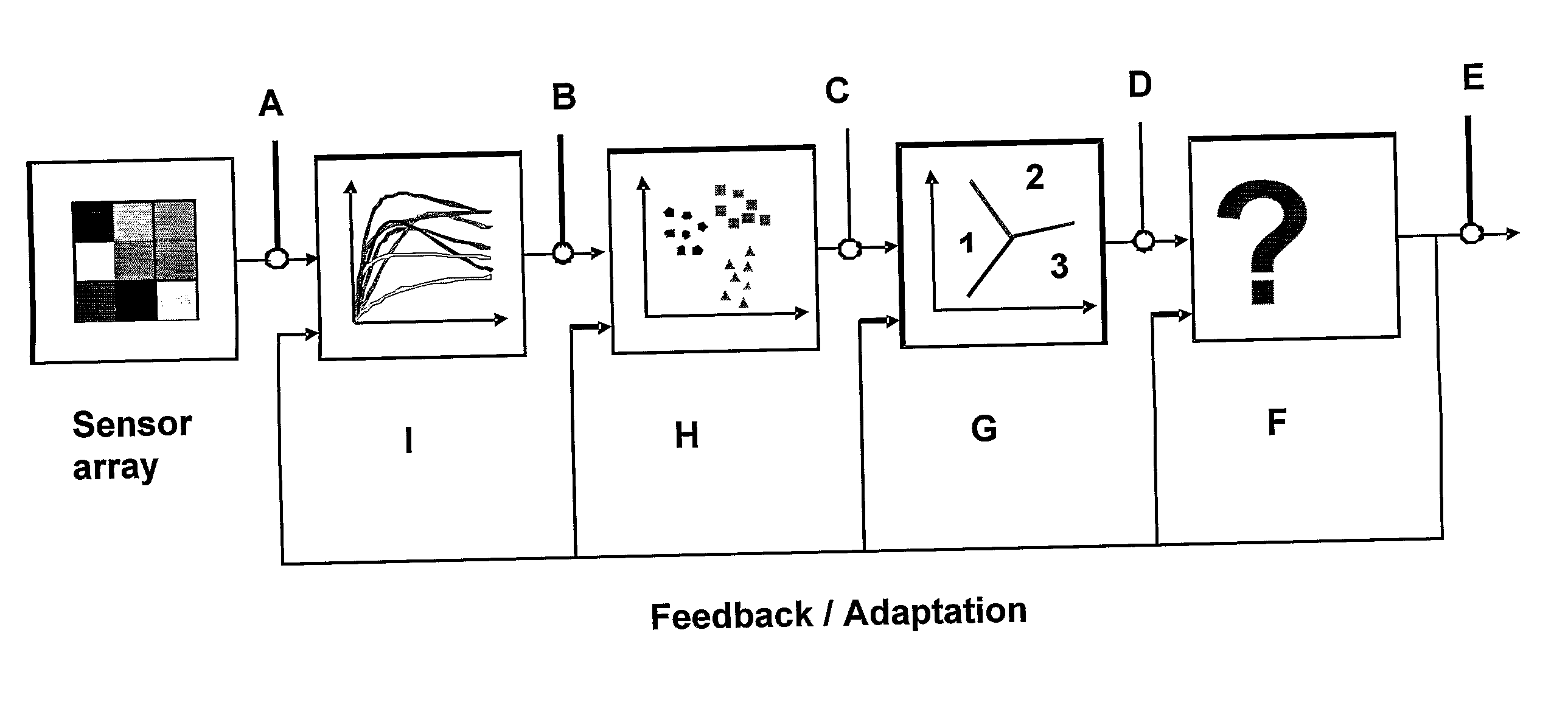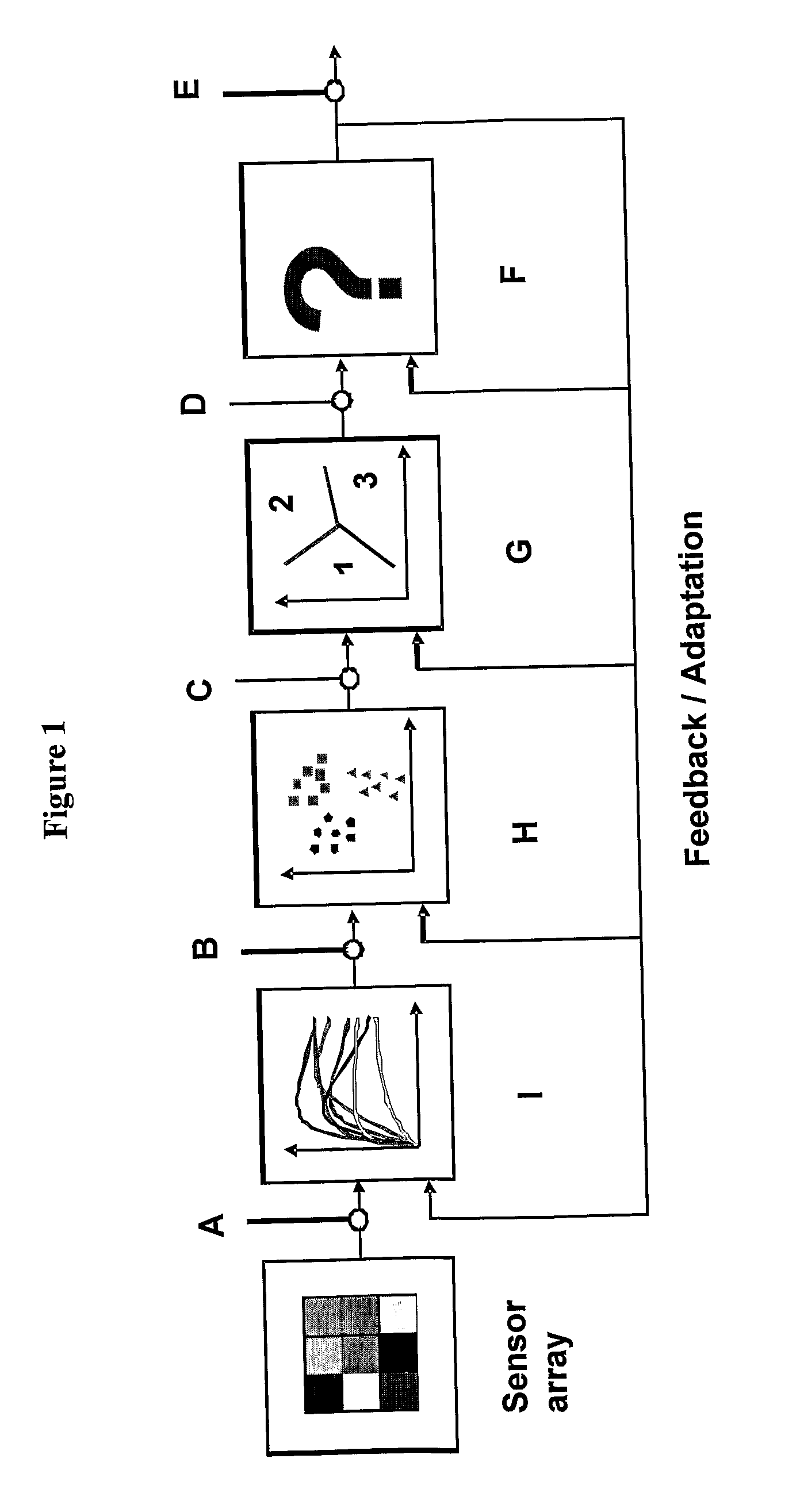Electronic nose device with sensors composed of nanowires of columnar discotic liquid crystals with low sensititive to humidity
a technology of liquid crystal liquid and nanowires, which is applied in the field of electronic nose devices with sensors composed of nanowires of columnar discotic liquid crystals with low sensitivity to humidity, can solve the problems of expensive equipment, the degree of expertise required to operate such instruments, and the length of data acquisition tim
- Summary
- Abstract
- Description
- Claims
- Application Information
AI Technical Summary
Benefits of technology
Problems solved by technology
Method used
Image
Examples
example 1
Composition and Synthesis of the Columnar Discotic Liquid Crystals
[0094]The columnar discotic liquid crystals of the present invention were produced from molecules provided from the group of Prof. Klaus Mullen, Max-Planck Institute for Polymer Research, Mainz, Germany. In particular, hexa-peri-hexabenzocoronene (HBC) molecules having the following functional groups: HBC-C6-2, HBC-C10,6, HBC-C14-10, and HBC-C12 were synthesized according to methods well known in the art, see e.g. Watson et al., J. Am. Chem. Soc., 126(5), 1402, 2004; Pisula et al., J. Am. Chem. Soc., 126(26), 8074, 2004; Wang & Mullen, J. Org. Chem., 69(24), 8194, 2004.
example 2
Self-Assembly of the Discotic Liquid Crystal Nanowires
[0095]The length and diameter of the DLC nanowires of the present invention is dependant on various experimental parameters, such as the concentration level of the molecules, the type of the solvent / solution, and the deposition mode. In particular, the molecules in a concentration range of 10−7-10−3 M self-assemble in any one of the following manners:[0096]1. molecules are stacked one on top of the other in solution / solvent to form wire-like structures, followed by deposition on a substrate using methods such as spin coating, spray coating, Langmuir-Blodgett, zone-casting, or drop casting, well known in the art.[0097]2. molecules stay unassembled in solution / solvent and are consequently assembled namely stacked one on top of the other directly on the substrate.
[0098]Controlling the dimensions of the nanowire is performed by varying the manner in which self-assembly is performed or alternatively by tailoring parameters such as the...
example 3
Fabrication of the Electronic Device
[0100]Discotic liquid crystal nanowires produced as described hereinabove, are dispersed from solution / solvent (e.g., THF or toluene) onto a doped silicon substrate containing a thin film of dielectric layer mainly composed of SiO2 and ZrO2.
[0101]The contacts to the DLC nanowires are performed by electron beam lithography followed by evaporation of a metal that forms an ohmic contact (Stern, J. Vac. Sci. Technol. B, 24, 231, 2006). The electrodes for measuring the electrical properties of the deposited discotic liquid crystals are produced by various processes well known in the art which include, but are not limited to, photolithography, e-beam lithography, focused ion beam (FIB), direct evaporation / sputtering through shadow mask, and soft stamp contact.
[0102]The electronic devices of the present invention are fabricated in an edge-on configuration, wherein the DLC nanowires are laid down on the substrate allowing the electrodes to be connected at...
PUM
 Login to View More
Login to View More Abstract
Description
Claims
Application Information
 Login to View More
Login to View More - R&D
- Intellectual Property
- Life Sciences
- Materials
- Tech Scout
- Unparalleled Data Quality
- Higher Quality Content
- 60% Fewer Hallucinations
Browse by: Latest US Patents, China's latest patents, Technical Efficacy Thesaurus, Application Domain, Technology Topic, Popular Technical Reports.
© 2025 PatSnap. All rights reserved.Legal|Privacy policy|Modern Slavery Act Transparency Statement|Sitemap|About US| Contact US: help@patsnap.com



